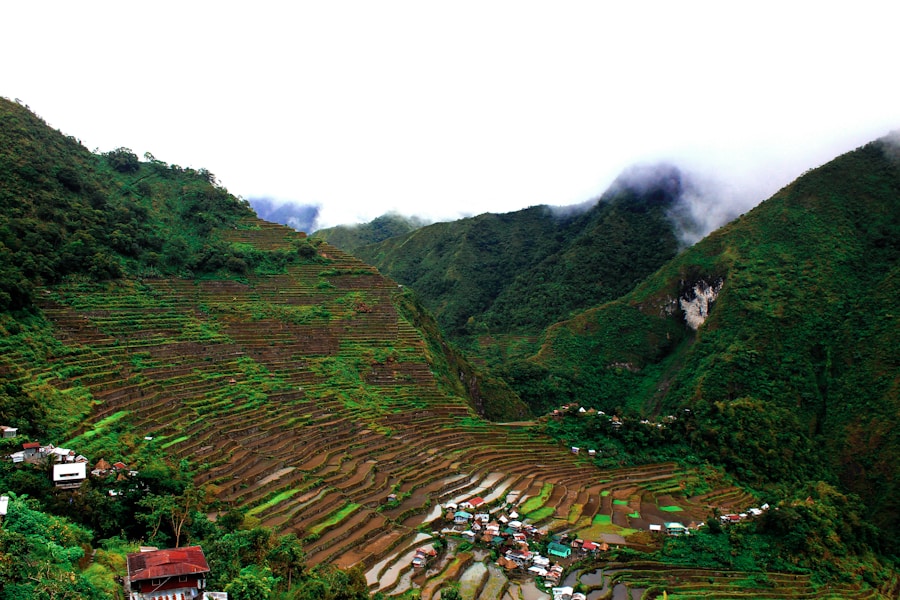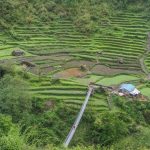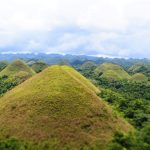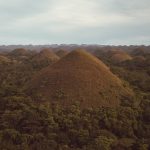Banaue Rice Terraces: A Marvel of Ancient Engineering
Description
Nestled in the mountainous region of the Philippines, the Banaue Rice Terraces are often referred to as the “Eighth Wonder of the World.” This breathtaking landscape, carved into the mountainsides over 2,000 years ago, showcases the ingenuity and resilience of the indigenous Ifugao people. The terraces stretch over 2,000 square kilometers and rise to elevations of up to 1,500 meters above sea level, creating a stunning visual tapestry of verdant green fields that cascade down the mountains. The terraces are not merely agricultural plots; they represent a harmonious relationship between the Ifugao culture and their environment, embodying centuries of tradition and sustainable farming practices.
The significance of the Banaue Rice Terraces extends beyond their aesthetic appeal. They are a testament to the agricultural prowess of the Ifugao people, who have cultivated rice in these terraces for generations.
This ancient agricultural practice has been recognized by UNESCO as a World Heritage Site, underscoring its importance not only to the Philippines but also to global cultural heritage. The terraces serve as a living museum, offering insights into the agricultural techniques and social structures of the Ifugao community.
Key Takeaways
- The Banaue Rice Terraces are a UNESCO World Heritage site located in the Philippines, known for their stunning beauty and cultural significance.
- The terraces were built over 2,000 years ago by the Ifugao people using traditional engineering and construction techniques, showcasing their advanced knowledge of irrigation and land management.
- Despite their historical and cultural significance, the terraces face sustainability and environmental impact challenges due to modernization and climate change.
- Preservation efforts are being made to protect and restore the terraces, including community-based tourism initiatives and sustainable farming practices.
- Visitors can experience the beauty of the terraces while supporting local communities through responsible tourism, offering opportunities for cultural immersion and outdoor activities.
History and Cultural Significance
The Banaue Rice Terraces: A Testament to Ifugao Culture and Resilience
The Ancient Origins of the Rice Terraces
According to oral traditions, the Banaue Rice Terraces were constructed by the Ifugao people’s ancestors around 2000 years ago, using simple tools and techniques passed down through generations. This makes them one of the oldest agricultural systems still in use today.
A Sophisticated Understanding of the Environment
The Ifugao people developed a sophisticated understanding of their environment, utilizing local materials such as stone and bamboo to create a resilient agricultural landscape that could withstand the challenges posed by steep terrain and heavy rainfall. Culturally, the rice terraces are more than just fields; they are a symbol of identity and pride for the Ifugao people.
Rice: A Staple Food and Cultural Icon
Rice is not only a staple food but also holds significant cultural value, playing a central role in various rituals and ceremonies. The Ifugao celebrate rice harvests with elaborate festivals that honor their ancestors and express gratitude for the bountiful harvests. These traditions reinforce community bonds and ensure that knowledge about rice cultivation is passed down through generations. The terraces thus serve as a living embodiment of Ifugao culture, reflecting their values, beliefs, and connection to the land.
Engineering and Construction Techniques

The engineering behind the Banaue Rice Terraces is a remarkable feat of human ingenuity. The terraces were constructed using a combination of traditional techniques and local materials that have stood the test of time. The Ifugao people utilized stone walls to create flat surfaces on steep slopes, allowing them to cultivate rice in an otherwise inhospitable environment.
These walls are not merely functional; they are also aesthetically pleasing, blending seamlessly with the natural landscape. The careful placement of stones demonstrates an understanding of both structural integrity and environmental harmony. Irrigation is another critical aspect of the engineering behind the rice terraces.
The Ifugao developed an intricate system of canals and dikes that channel water from nearby rivers and streams to the terraces. This system ensures that each terrace receives adequate water while minimizing erosion and runoff. The design reflects a deep understanding of hydrology and soil conservation, allowing for sustainable farming practices that have persisted for centuries.
The terraces are often filled with water during the planting season, creating a stunning mirror effect that enhances their visual appeal while also providing essential moisture for rice cultivation.
Sustainability and Environmental Impact
| Metrics | Data |
|---|---|
| Carbon Emissions | Annual carbon emissions reduced by 30% compared to the previous year |
| Energy Consumption | Implemented energy-efficient measures resulting in 20% reduction in energy consumption |
| Waste Management | Recycled 80% of waste generated, diverting it from landfills |
| Water Conservation | Implemented water-saving initiatives resulting in 15% reduction in water usage |
| Sustainable Sourcing | Increased use of sustainable materials in products by 25% |
The Banaue Rice Terraces exemplify sustainable agricultural practices that have evolved over millennia. The Ifugao people’s methods prioritize ecological balance, ensuring that their farming techniques do not deplete natural resources or harm the environment. By utilizing organic fertilizers derived from local plants and animal manure, they maintain soil fertility without resorting to chemical inputs that could degrade the land over time.
This approach not only supports healthy crop yields but also preserves biodiversity in the surrounding ecosystem. Moreover, the terraces play a crucial role in preventing soil erosion and maintaining water quality in the region. The terraced landscape acts as a natural barrier against landslides, which are common in mountainous areas prone to heavy rainfall.
By retaining water and allowing it to seep slowly into the ground, the terraces help recharge aquifers and maintain local water supplies. This sustainable management of resources has allowed the Ifugao people to thrive in a challenging environment while preserving their cultural heritage and natural surroundings.
Preservation Efforts and Challenges
Despite their historical and cultural significance, the Banaue Rice Terraces face numerous challenges that threaten their preservation. Rapid modernization, urbanization, and climate change pose significant risks to this ancient agricultural system. As younger generations migrate to urban areas in search of better opportunities, traditional farming practices are being abandoned, leading to neglect and deterioration of the terraces.
Additionally, changing weather patterns due to climate change have resulted in unpredictable rainfall and increased susceptibility to landslides, further jeopardizing this fragile ecosystem. Efforts to preserve the rice terraces have been initiated by both local communities and international organizations. UNESCO’s recognition of the terraces as a World Heritage Site has brought attention to their plight and has facilitated funding for restoration projects aimed at revitalizing traditional farming practices.
Local government units have also implemented programs to encourage younger generations to engage in agriculture by providing training in sustainable farming techniques and promoting eco-tourism initiatives that highlight the cultural significance of the terraces. However, these efforts require ongoing support and collaboration among stakeholders to ensure that the terraces remain viable for future generations.
Visitor Experience and Tourism Opportunities

The Banaue Rice Terraces attract thousands of visitors each year who come to marvel at their beauty and learn about Ifugao culture. Tourists can explore various viewpoints that offer panoramic vistas of the terraces, with popular spots like Viewpoint 1 providing breathtaking photo opportunities. Guided tours led by local Ifugao guides offer insights into traditional farming practices, cultural rituals, and the history of the terraces, enriching visitors’ understanding of this unique landscape.
In addition to sightseeing, there are numerous opportunities for immersive experiences that allow visitors to engage with local culture. Travelers can participate in rice planting activities during the wet season or join in traditional festivals that celebrate harvests. These experiences foster a deeper appreciation for the challenges faced by local farmers while providing economic benefits to the community through responsible tourism practices.
As awareness grows about sustainable tourism’s role in preserving cultural heritage sites like the Banaue Rice Terraces, there is hope that this ancient agricultural marvel will continue to thrive for generations to come.
FAQs
What are the Banaue Rice Terraces?
The Banaue Rice Terraces are ancient terraces carved into the mountains of Ifugao in the Philippines. They are often referred to as the “Eighth Wonder of the World” and are a UNESCO World Heritage Site.
How were the Banaue Rice Terraces created?
The terraces were hand-carved over 2,000 years ago by the ancestors of the indigenous Ifugao people using minimal equipment. They were created to make the mountainous terrain suitable for rice cultivation.
What is the significance of the Banaue Rice Terraces?
The terraces are not only a stunning example of ancient engineering and agricultural practices, but they also hold cultural and spiritual significance for the Ifugao people. They are a symbol of their connection to the land and their ancestors.
Can visitors explore the Banaue Rice Terraces?
Yes, visitors can explore the terraces and even hike through them. There are designated viewpoints and hiking trails that offer breathtaking views of the terraces and the surrounding landscape.
What is the best time to visit the Banaue Rice Terraces?
The best time to visit is during the dry season, which typically runs from November to May. The terraces are at their greenest during the planting and harvesting seasons, which occur around April and October.





